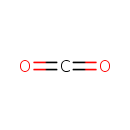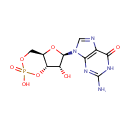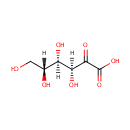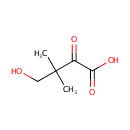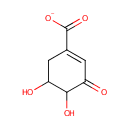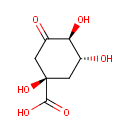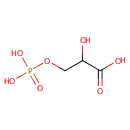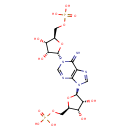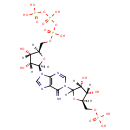
Search Results for compounds
Searching compounds for
returned 4373 results.
Carbon dioxide (PAMDB000568)
IUPAC:
methanedione
CAS: 124-38-9
Description: Carbon dioxide (chemical formula: CO2) is a chemical compound composed of two oxygen atoms covalently bonded to a single carbon atom. It is a gas at standard temperature and pressure and exists in the Earth's atmosphere in this state. It is produced during respiration by plants, as well as all animals, fungi and microorganisms that depend either directly or indirectly on plants for food. Carbon dioxide has no liquid state at pressures below 5.1 atmospheres. At 1 atmosphere (near mean sea level pressure), the gas deposits directly to a solid at temperatures below
Cyclic GMP (PAMDB000570)
IUPAC:
9-[(4aR,6R,7R,7aS)-2,7-dihydroxy-2-oxo-hexahydro-2???furo[3,2-d][1,3,2]dioxaphosphinin-6-yl]-2-amino-6,9-dihydro-1H-purin-6-one
CAS: 7665-99-8
Description: Guanosine cyclic 3',5'-(hydrogen phosphate). A guanine nucleotide containing one phosphate group which is esterified to the sugar moiety in both the 3'- and 5'-positions. It is a cellular regulatory agent and has been described as a second messenger.
Chloride (PAMDB000573)
IUPAC:
chloride
CAS: 16887-00-6
Description: The chloride ion is formed when the element chlorine picks up one electron to form an anion (negatively-charged ion) Cl. Chloride is an important anion in all living systems (being part of NaCl and KCl) and cells actively transport chloride ions to help maintain an appropriate ion balance.
2-Dehydro-D-gluconate (PAMDB000575)
IUPAC:
(3S,4R,5R)-3,4,5,6-tetrahydroxy-2-oxohexanoic acid
CAS: Not Available
Description: 2-Keto-L-gluconate is a derivative of gluconic acid, which occurs naturally in fruit, honey and wine and is used as a food additive, an acidity regulator. It is also used in cleaning products where it helps cleaning up mineral deposits. It is a strong chelating agent, especially in alkaline solution. It chelates the anions of calcium, iron, aluminium, copper, and other heavy metals. Pseudomonas aeruginosa contains ketogluconate reductase genes, so it is likely that pathways exist for the metabolism of ketogluconate
2-Dehydropantoate (PAMDB000576)
IUPAC:
4-hydroxy-3,3-dimethyl-2-oxobutanoic acid
CAS: Not Available
Description: 2-dehydropantoate belongs to the class of Branched Fatty Acids. These are fatty acids containing a branched chain. (inferred from compound structure)2-dehydropantoate is invovled in Pantothenate and CoA biosynthesis, and Biosynthesis of secondary metabolites. (KEGG)
3-Dehydro-shikimate (PAMDB000581)
IUPAC:
4,5-dihydroxy-3-oxocyclohex-1-ene-1-carboxylate
CAS: 10457-99-5
Description: 3-dehydro-shikimate is invovled in Chorismic acid biosynthesis. (KEGG)
3-Dehydroquinate (PAMDB000582)
IUPAC:
(1R,3R,4S)-1,3,4-trihydroxy-5-oxocyclohexane-1-carboxylic acid
CAS: Not Available
Description: 3-dehydroquinate is a member of the chemical class known as Cyclitols and Derivatives. These are compounds containing a cycloalkane moiety with one hydroxyl group on each of three or more ring atoms. 3-dehydroquinate is invovled in phenylalanine, tyrosine and tryptophan biosynthesis, and the biosynthesis of secondary metabolites. Dehydroquinate is involved in the shikimate pathway. The aroB-encoded enzyme dehydroquinate synthase is the second enzyme of this pathway, and it catalyzes the cyclization of 3-deoxy-D-arabino-heptulosonate-7-phosphate in 3-dehydroquinate. The aroB-encoded enzyme dehydroquinate synthase is the second enzyme of this pathway, and it catalyzes the cyclization of 3-deoxy-D-arabino-heptulosonate-7-phosphate in 3-dehydroquinate. (PMID 17586643) The aroB gene encoding dehydroquinate synthase (DHQS), which is a potential antibiotic target, was identified from the plant-pathogenic bacterium Xanthomonas oryzae pv. (PMID 19052366)
3-Phosphoglycerate (PAMDB000628)
IUPAC:
2-hydroxy-3-(phosphonooxy)propanoic acid
CAS: 820-11-1
Description: 3-phosphoglyceric acid (3PG) is a 3-carbon molecule that is a metabolic intermediate in both glycolysis and the Calvin cycle. This chemical is often termed PGA when referring to the Calvin cycle. In the Calvin cycle, two glycerate 3-phosphate molecules are reduced to form two molecules of glyceraldehyde 3-phosphate (GALP). (wikipedia)
Phosphoribosyl-AMP (PAMDB000630)
IUPAC:
{[(2R,3S,4R,5R)-5-{1-[(2S,3R,4S,5R)-3,4-dihydroxy-5-[(phosphonooxy)methyl]oxolan-2-yl]-6-imino-6,9-dihydro-1H-purin-9-yl}-3,4-dihydroxyoxolan-2-yl]methoxy}phosphonic acid
CAS: Not Available
Description: Phosphoribosyl-AMP is a nucleic acid component, a purine-related compound. It is an intermediate in histidine biosynthesis. It is converted from Phosphoribosyl-ATP via the enzyme phosphoribosyl-ATP diphosphatase (EC 3.6.1.31). It is then converted to phosphoribosylformiminoAICAR-phosphate via the enzyme phosphoribosyl-AMP cyclohydrolase (EC 3.5.4.19).
Phosphoribosyl-ATP (PAMDB000631)
IUPAC:
({[({[(2R,3S,4R,5R)-5-{1-[(3R,4S,5R)-3,4-dihydroxy-5-[(phosphonooxy)methyl]oxolan-2-yl]-6-imino-6,9-dihydro-1H-purin-9-yl}-3,4-dihydroxyoxolan-2-yl]methoxy}(hydroxy)phosphoryl)oxy](hydroxy)phosphoryl}oxy)phosphonic acid
CAS: Not Available
Description: Phosphoribosyl-ATP takes part in the Histidine Metabolism pathway.[KEGG ID C02739]. Specifically, Phosphoribosyl-ATP is substrate for phosphoribosyl pyrophosphate synthetase 1.
